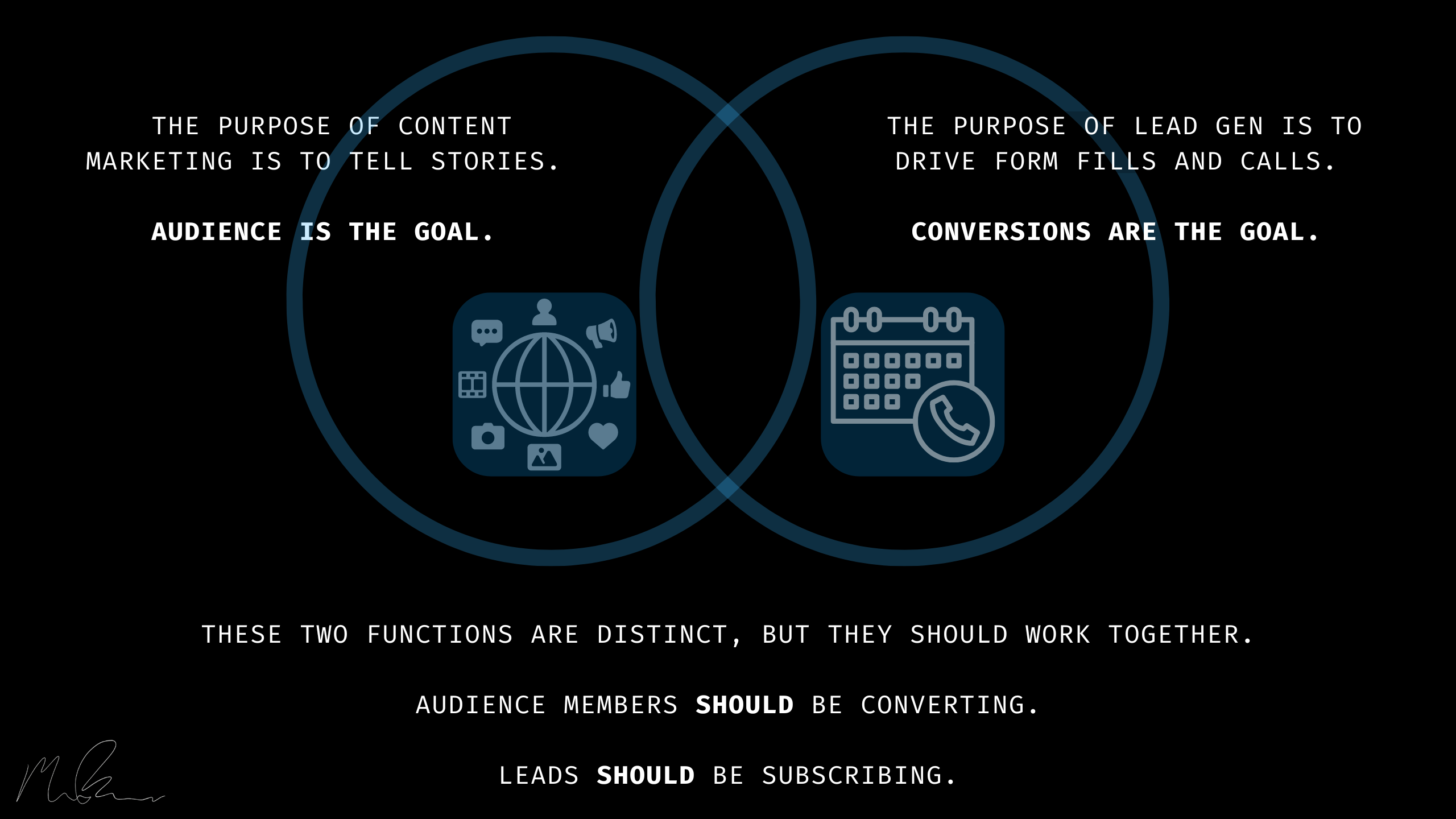Your cart is currently empty!

How to Win by Investing in Content Marketing
As the war for attention rages on, the edge is shifting to those who have the best content and most committed audience, not the best product.
Most people think “content marketing” means making content to drive demand for the product being sold. It’s not about that. Content marketing means building a media hub to house original programming that creates subscribers (a fraction of whom will buy from you down the line).
To put a definition around the term, content marketing is:
The consistent delivery of one media type across one (or several) vehicles with the expressed purpose of building an opt-in database that knows, likes, and trusts the sponsoring creator.
Audiences of the best brands do not even view the creator behind the wheel as a commercial entity. It’s all about the energy, the excitement, and the reprieve from reality that’s available by consuming whatever’s being produced.
Content marketing in action: Ellen
Perhaps the best content marketer I’ve ever seen is someone who likely didn’t even think about herself as a content marketer, yet consistently generated over $100 million in ad revenue every six months over a 20-year term of consistent airing: Ellen DeGeneres.
Ellen didn’t make content; she put on a show. She didn’t talk to an audience; she created a family. She didn’t sell; she served. The way her worldwide fans adored her, and would go absolutely crazy in the studio, is exactly how all creators need to be seeking to engage those who follow them.
Take a minute, and go pull up a clip from her show—but with a keen eye on the audience. Look at how they laughed, cried, cheered, admired, and loved their leader. This is the extent to which your fans should clamor to engage with you. Are they?
In addition to tribe building, from a pure business perspective, the purpose of content marketing is to teach your followers everything they need to know to transform into the people you need them to be to eventually become high-lifetime-value customers. In building a content property—one that is separate and discrete from the things you sell—you have a vehicle that inherently confirms authority, showcases expertise, and supports ongoing idea transmission. I often call this external vault of value a content hub. It should be a virtual library of everything you believe, hold true, and know about your space. For Ellen, this is her YouTube page.
For most brands, assuming it’s executed well, a content marketing investment requires an 18- to 24-month runway before it will begin to work. After a year to two years of consistent platform building, a creator can expect to start to be featured in recommendations, gain autopilot follower flow, monetize that base, and garner initial influence. But it takes time, commitment, and a willingness to both wait and withhold the pitch.
Content marketing is the consistent dissemination of multimedia that attracts subscribers who ultimately become better customers down the line.
In a word, content marketing is about fulfillment. The mandate is to fulfill on your promise to solve your audience’s problem (by giving them the “how”) and then to monetize execution via a paid product. In other words: share the secrets; then sell the implementation.
If you don’t share everything—if you withhold any of what you know, if you simply cannot bring yourself to give away information that feels like it should be worth thousands of dollars—you will be made obsolete by competitors who see how the market is moving and have already made that mind shift without thinking twice.
| Make Content a Demonstration of What You Do The best content shows and tells. Make your marketing a literal display of the product (or result) that you sell. If you sell lead gen, create content that generates leads for you. If you sell coaching, post snippets from sessions with (or go live alongside) customers. Content that serves as an embodiment of what you provide will display the way in which it works, verifying validity for followers. |
This is something to go all in on. Half-assed content defeats the purpose, which is a reality that many matrixed, mechanical organizations know (or don’t) all too
Why enterprises fail at content
Free dissemination of knowledge is second nature for many young online entrepreneurs to whom this model is self-evident. But it’s a new muscle for many big brands. In general, the bigger a company is, the more misguided it seems to be about what content marketing really means, which is why most companies that try to do it fail.
Pressured by the need to hit quarterly pipeline targets, content teams are under orders to generate leads . . . or risk losing their jobs. Self-promotion and CTAs for sales calls are the most obvious short-term Band-Aid; yet they never seem to help (because they’re all push and no pull).
Another mistake that big brands make is that they hire content marketers but then start assigning them sales enablement, email, social media, ad copy, direct response, event support, and product marketing tasks—all the things that may be important pieces of the integrated marketing puzzle but in and of themselves are not content marketing.
These big enterprises tend to tie their content team’s hands behind their back and then fire them when they don’t see results that never had a chance of materializing in the first place.
Content marketing is not direct response, ads, web copy, sales enablement, event support, social media, prospecting, executive comms, or PR. These are defined, standalone functions.
To be clear: I am not saying not to do prospecting, to run ads, to do email campaigns, or direct response—do those things! Chances are, you need them. You just need them running in tandem with, and separately from, your content marketing platform.
| Content Marketing vs. Lead Generation The purpose of content marketing is not to drive leads. It’s to execute an ongoing show or series or platform for telling stories. Audience building is the goal. The purpose of lead generation as a function is to drive form fills and calls. Conversions are the goal. We have to stop confusing these two discrete activities. They aren’t interchangeable; yet at the same time, they absolutely must compliment one another. An audience should be converting. Leads should be subscribing. When audience members decide they want to take action and invest in your paid options, they should be able to do so easily. Conversely, what’s the first thing a DM recipient does when they see that cold message come through? They go look at your content hub to see more about what you publish, preach, and promote. These two critical business functions must operate independently, but they hold up one another as well. It’s the yin and yang of modern-day demand. |
Big companies, in particular, often make another ruinous mistake. They have their multi member content team creating 101-level subject matter for a target whose baseline is at least at 301.
Are seasoned physicians really going to read a rudimentary piece of content written by someone who has never been in medicine spouting off generic ideas to try to sell a medtech product? Or are they subscribing to medical journals where independent experts write on topics they actually want to learn about?
Are experienced marketing veterans really reading a rudimentary blog post by an email deliverability vendor’s junior writer? Or are they subscribing to podcasts of well-respected email analysts who know the space inside and out?
The point is that truly effective content has to be—can only be—generated from expert sources. Often, this includes independent entrepreneurs, users and customers, or partners who can at least provide data points and perspectives to help guide the person at the helm. I wrote about decentralized media houses in an article, here.
You can’t succeed with content marketing if you don’t understand what it truly is in the first place, which, to reiterate, means running a media hub that stands apart from the products and services you sell. Eventually, the content will sell the product indirectly but isn’t meant to inherently.
Let’s look at a couple more examples of content marketing done right.
Example: Comedy Central’s “Animated” YouTube channel (B2C)
Comedy Central (CC) has a branded YouTube channel to build subscribers, provide independent value from its primary platform, and send traffic to its website.
The content, guests, and topics are almost entirely separate from the CC brand, but still support it with subtle calls to action.
Example: The Bedros Keuilian Podcast (B2C)
Influencer Bedros Keuilian uses a front-end content marketing podcast that’s separate from the multiple businesses he owns, but that nonetheless drives demand for those products. I showcase this example in the book.
Example: The Orbit Media Studios blog (B2B)
Orbit Media’s top-tier blog provides evidence of the company’s expertise while its leader, Andy Crestodina, has a strong following on LinkedIn which serves as a pseudo “VIP community” helping lead to more business for his company.
These companies do not treat content as a liability or a “nice to have.” On the contrary, their content is their marketing. They don’t execute content initiatives underneath a marketing umbrella; marketing actually falls under the roof of their content-first model.
And they’re not alone in this approach. Look at countless others like Netflix, Spotify, HubSpot, Masterclass, and Clickfunnels—media-driven companies who don’t “do marketing” in the traditional sense but instead feature tech-driven content as their product. Any marketing they do falls under the roof of content.
Whether you’re a digital company or not, this is the kind of thinking that the most well-liked brands are moving towards, and that you can embrace, too.
Final Thoughts
Content marketing is an investment, and at first, it will be an expense. That means that research (time), hard work (energy), and production (headcount and other resources) will need to be allocated no matter what avenue or method is leveraged.
You won’t see much of a return at first. Much in the same way a high-tech startup takes on capital pre-revenue precisely so that it can get to the point of making money, companies need to be willing to invest in content in order to get the audience that will ultimately drive the revenue engine. The gamble is that an up-front loss will create a bigger back-end win.
Prepare to take a cash loss up front investing in resources solely so you can give away better free content in exchange for the intangible goodwill it will generate.
This investment in content and audience is worth it—the revenue potential of a subscribed audience represents several times that of the same volume of non subscribed cold prospects.
As followers go from like, to loyal, to love, price becomes nearly inconsequential, as a genuine desire to engage with your company outweighs any other factor, barrier, or objection. And it’s all predicated on giving away the tool shed without extracting anything in return for as long as you can hold out.
Are you willing to play that game? The most well-liked internet personalities and educational providers in the world are already there.
📘 Grab your copy of CONTENT CAPITALIST here.

Leave a Reply